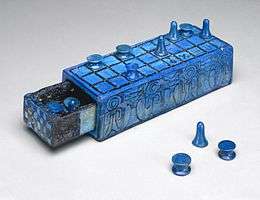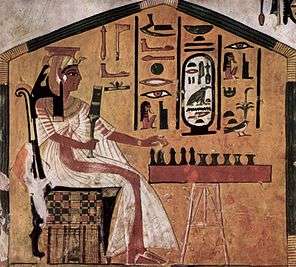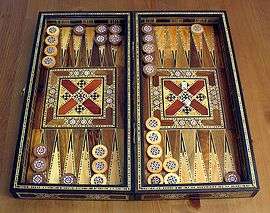Senet
 Senet gaming board inscribed for Amenhotep III with separate sliding drawer, c. 1390–1353 BC |
Senet (or senat[1]) is a board game from ancient Egypt, whose original rules are the subject of conjecture. The oldest hieroglyph resembling a senet game dates to around 3100 BC.[2] The full name of the game in Egyptian is thought to have been zn.t n.t ḥˁb, meaning the "game of passing".[3]
History
Senet is one of the oldest known board games. Fragmentary boards that could be senet have been found in First Dynasty burials in Egypt,[2] c. 3100 BC. A hieroglyph resembling a senet board appears in the tomb of Merknera (3300–2700 BC).[4] The first unequivocal painting of this ancient game is from the Third Dynasty tomb of Hesy (c. 2686–2613 BC). People are depicted playing senet in a painting in the tomb of Rashepes, as well as from other tombs of the Fifth and Sixth Dynasties (c. 2500 BC).[5] The oldest intact senet boards date to the Middle Kingdom, but graffiti on Fifth and Sixth Dynasty monuments could date as early as the Old Kingdom.[3]
| Senet in hieroglyphs | ||||
|---|---|---|---|---|
|
Senet (Sn.t, "passage/gateway") | ||||
 | ||||
At least by the time of the New Kingdom in Egypt (1550–1077 BC), senet was conceived as a representation of the journey of the ka (the vital spark) to the afterlife. This connection is made in the Great Game Text, which appears in a number of papyri, as well as the appearance of markings of religious significance on senet boards themselves. The game is also referred to in chapter XVII of the Book of the Dead.[6]
Senet also was played by people in neighboring cultures, and it probably came to those places through trade relationships between Egyptians and local peoples.[7] It has been found in the Levant at sites such as Arad[8] and Byblos, as well as in Cyprus.[9] Because of the local practice of making games out of stone, there are more senet games that have been found in Cyprus than have been found in Egypt.[10]
Gameplay
The senet gameboard is a grid of 30 squares, arranged in three rows of ten. A senet board has two sets of pawns (at least five of each). Although details of the original game rules are a subject of some conjecture, senet historians Timothy Kendall and R. C. Bell have made their own reconstructions of the game.[11] These rules are based on snippets of texts that span over a thousand years, over which time gameplay is likely to have changed. Therefore, it is unlikely these rules reflect the actual course of ancient Egyptian gameplay.[7] Their rules have been adopted by sellers of modern senet sets.
In a presentation to the XX Board Games Studies Colloquium at the University of Copenhagen, Denmark, Espen Aarseth asked if the game Senet could be said to still exist, given that the rules were unknown.[12] In response, Alexander de Voogt of the American Museum of Natural History pointed out that games did not have a fixed set of rules, but rules varied over time and from place to place. Moreover, many players of games, even today, do not play (or sometimes do not even know) the "official rules".
Games historian Eddie Duggan (University of Suffolk) provides a brief resume of ideas related to the ancient Egyptian game of senet (together with an overview of the so-called "Royal Game of Ur") and a version of rules for play in his teaching notes on ancient games.[13]
See also
References
- ↑ "A History of Board Games". Archived from the original on 2003-12-05. Retrieved 2010-08-16.
- 1 2 In Search of the Meaning of Senet Archived 2008-09-18 at the Wayback Machine. by Peter A. Piccione
- 1 2 Piccione, Peter (1990). The Historical Development of the Game of Senet and its Significance for Ancient Egyptian Religion. Chicago: Unpublished PhD Dissertation, University of Chicago.
- ↑ Pivotto, Carlos; et al. "Detection of Negotiation Profile and Guidance to more Collaborative Approaches through Negotiation Games" (PDF). Retrieved 2014-10-02.
- ↑ Metha Melissa Wijoyono; Alvin Raditya (10 July 2014). "Perancangan Permainan Media Edukasi Sebagai Pembelajaran Cara Melindungi Diri Dalam Menghadapi Bencana Alam Bagi Anak Usia 7–12 Tahun". Jurnal DKV Adiwarna (in Indonesian). 1 (4): 12.
- ↑ "Egyptian Symbols: Senet". Retrieved 23 February 2016.
- 1 2 Crist, Walter; et al. (2016). "Facilitating Interaction: Board Games as Social Lubricants in the Ancient Near East". Oxford Journal of Archaeology. 35 (2): 179–196. doi:10.1111/ojoa.12084.
- ↑ Sebbane, Michael (2001). "Board Games from Canaan in the Early and Intermediate Bronze Ages and the Origin of the Egyptian Senet Game". Tel Aviv. 28 (2): 213–30. doi:10.1179/tav.2001.2001.2.213.
- ↑ Swiny, Stuart (1986). The Kent State Expedition to Episkopi-Phaneromeni. Nicosia: Paul Astroms Forlag.
- ↑ Crist, Walter; et al. (2016). Ancient Egyptians at Play: Board Games across Borders. Bloomsbury. ISBN 978-1-4742-2117-7.
- ↑ Soubeyrand, Catherine. "The Game of Senet". Retrieved 2014-10-25.
- ↑ Aarseth, E. (2017) "Does Senet Still Exist? The Ontology of a Game without Rules". Presentation to XX Board Game Studies Colloquium: Models, Metaphors, Meanings. University of Copenhagen. May 17–20 2017.
- ↑ Duggan. E. (2015) Ancient Board Games 1. The Royal Game of Ur and Senet (Revision C, 2015).
Bibliography
- Crist, Walter; Anne-Elizabeth Dunn-Vaturi; Alex de Voogt (2016). Ancient Egyptians at Play: Board Games Across Borders. New York, NY: Bloomsbury. pp. 41–80. ISBN 978-1-4742-2117-7.
- Kendall, Timothy (1978). Passing Through the Netherworld: The meaning and play of Senet, an ancient Egyptian funerary game. Belmont, Massachusetts: Kirk Game Company.
- Piccione, Peter A. (2007). Finkel, Irving L., ed. Ancient Board Games in perspective. London: British Museum Press. pp. 54–63. ISBN 978-0-714-11153-7.
Further reading
- Bell, R. C. (1979) [1st Pub. 1960, Oxford University Press, London]. Board and Table Games From Many Civilizations. I (Revised ed.). Dover Publications Inc. pp. 26–28. ISBN 978-0-671-06030-5.
- Bell, R. C. (1983). "Senat". The Boardgame Book. Exeter Books. pp. 82–83. ISBN 978-0-671-06030-5.
- Falkener, Edward (1961) [1892]. "§V. The Game of Senat". Games Ancient and Oriental and How to Play Them. Dover Publications Inc. pp. 63–82. ISBN 978-0-486-20739-1.
- Grunfeld, Frederic V. (1975). "Senat". Games of the World. Holt, Rinehart and Winston. pp. 53–55. ISBN 978-0-03-015261-0.
External links
| Wikimedia Commons has media related to Senet. |
